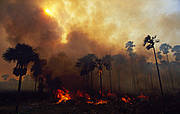Mediterranean forests are a buring issue
15 September 2008 | News story
By Richard Waddington on behalf of IUCN
From Lebanon to Lisbon, the Mediterranean summer produces more than just suntans; the dry heat so beloved of holidaymakers also creates the perfect conditions for forest fires.
On average, some 400,000 hectares of forest go up in smoke each year in the region, notably in Portugal, Spain, Italy and Greece, creating billions of euros worth of damage and all too often taking human lives.
The United Nations Food and Agriculture Organisation (FAO) estimates that there are over 50,000 fires each summer and that more than 90 per cent of them are started by people, either deliberately or accidentally.
The fires, together with unrestrained urban sprawl, over-exploitation and land misuse in other parts of the region, threaten to deplete the Mediterranean forest ecosystems, one of the world’s richest stores of biodiversity. The Mediterranean basin is home to over 25,000 different species of flowering plants, half of which are unique to the basin.
Climate change threatens to make matters worse.
Not only will the more intense and frequent heat waves and hotter summers, predicted by climate change models, make forest fires more devastating, rising temperatures and lower rainfall pose their own problems of adaptation for the region’s flora and fauna, threatening the survival of many.
“Mediterranean forests face important threats…forest fires, climate change, agriculture, urban developments are eroding biodiversity,” said Juan Antonio Prado, FAO director of forest resources.
Environmentalist group WWF says the number of large-scale forest fires in the Mediterranean has increased dramatically over the last few decades.
The heat waves of 2003 and 2004, which provoked huge blazes across the northern Mediterranean climatic region, particularly in Portugal, were a taste of the sort of searing summer weather that can be expected with climate change. In 2007, Greece had its worst ever fires.
NO COUNTRY IS READY
Demographics also play a part. In recent times, the northern Mediterranean has witnessed significant movement of people out of the countryside and into the cities in search of better economic opportunities.
Fewer people living in mountainous, rural areas mean that when fires erupt they may be out of control before they are spotted. A general decrease in pastoral farming around forest areas leads to a build up of highly flammable forest litter and shrubs, which in turn fuels more intense and severe fires that are difficult to suppress.
In some areas, traditional agriculture and native trees, which have developed some resistance to fire, have been replaced by vast swathes of single-species plantations that are more vulnerable to fire.
Fires can play a positive role in forest dynamics, helping regenerate them, but only if they occur at a frequency dictated by nature. If they happen too often, then even species that are highly adapted to fire may not be able to recover: Changes in vegetation changes may occur, with scrubland expanding at the expense of forest, bringing with it a further risk of habitat loss.
“If the cycle is too short, the forest becomes degraded,” said Prado.
Despite the danger, most Mediterranean countries are still not doing enough to confront the problem, environmentalists say.
Northern Mediterranean countries spend over two billion euros a year in tackling fires and preparing their fire services to fight them; but they pay too little attention to preventive action in the form of effective forestry management.
“No country in the Mediterranean is ready to face the sort of heat wave we saw in 2003. This is why changes are needed in fire management to do more in prevention and land management measures, which help reduce fire vulnerability and increase ecological and social resilience against large scale fires” said Pedro Regato, senior Mediterranean programme manager for ecosystem management and development for the International Union for Conservation of Nature (IUCN).
The IUCN, which brings together governments, non-governmental organisations (NGO) and individual scientists in the world’s largest and oldest environmental body, is holding its four-yearly congress in Barcelona, Spain, October 5-14. Threats to biodiversity will be a key topic.
PORTUGAL – A STRIKING EXAMPLE
Portugal, with its huge eucalyptus plantations, offers a striking example of both what should and what should not be done.
When in 2003 fire destroyed vast areas of forest in Monchique, a nature preserve in the Algarve region of southern Portugal, environmentalists and the local authorities decided enough was enough.
The natural landscape had been heavily transformed by agriculture and the expansion of eucalyptus plantations from the 1950s through to the 1980s. The area hosts a number of endangered species, including the most likely few remaining Iberian lynx in Portugal.
In response to the devastation, the WWF and the Reforestation Commission in the Algarve set out to redesign the forest landscapes, mixing tree species such as cork, which have a higher level of fire resistance, with the eucalyptus.
Where plantations occupied river margins, they are being removed and replaced by natural vegetation. In the steepest areas, where eucalyptus was also being harvested, the Cansino project called for a switch to Mediterranean pasture land in order to create natural fire breaks.
All this was done in consultation with local landowners and users, because without their support, nothing could be achieved, said WWF’s Luis Neves Silva, a project coordinator. “It aims to support both biodiversity conservation and economic development in the region,” he said.
Portugal has applied similar principles of land management elsewhere, offering economic incentives to forest owners to carry out a more ecologically sustainable form of forestry.
For environmentalists, this careful deployment of a conservation strategy developed to meet local conditions and challenges is what is required to face the full range of threats to Mediterranean forests.
“They entered in a process of rethinking the forest strategy and what they should do… For me this is the way to proceed,” said Regato.
POOR AND INCONSISTENT MANAGEMENT
Similar thinking and action is required in other parts of the Mediterranean basin. Fires may be the most vivid and dramatic threat to forests, but poor or inexistent land management in the southern and eastern regions also takes a heavy toll.
Across much of North Africa, forest areas that were once well preserved are being rapidly degraded by over-grazing, logging and the indiscriminate cutting down of trees for fuel, environmentalists say.
Morocco, for example, is estimated to lose 31,000 hectares a year from such activities.
The eastern areas of the Mediterranean also suffer from illegal logging and unrestrained urban development. Forest fires, triggered by searing summer heat, caused heavy destruction of forests in Lebanon in 2007 and spurred the government into launching a national forestry recovery plan.
Rural communities, which have already suffered years of armed conflicts, depend for their economic survival on the grazing land and wood provided by the forests, but destruction at the rate seen in 2007 could eradicate Lebanon’s forests within a few decades.
ALL THE MORE URGENT
Amidst all this, climate change is increasing the urgency for action to conserve Mediterranean forests, environmentalists say.
Higher temperatures are already having a direct impact on tree distribution. In the south of France, for example, the Aleppo pine tree has shifted some 200 metres (yards) further up hillsides in search of better growing conditions, which are now higher up the mountains due to the effect of global warming.
With the sort of changes in temperature that are expected, the Mediterranean is probably a breeding ground for the trees and plants that will, in the future, become common in more central and northern areas of Europe, said Bruno Fady of the French National Institute for Agricultural Research (INRA).
“What we need for the Mediterranean is to increase the amount of protection that we have for the tree populations…They are a reservoir of genetic novelty for the future populations of Europe against climate change,” Fady said.
Opinions expressed in this article do not necessarily reflect the views of IUCN, its Council or its members.






